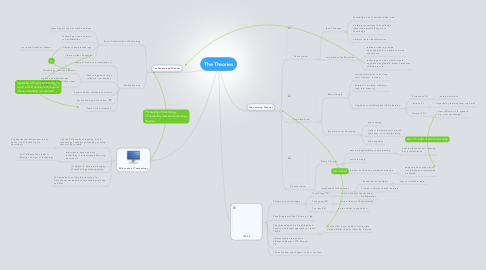
1. The Technology Theories
1.1. Social Construction of Technology
1.1.1. technology is used as machines/aides
1.1.2. Technology used as part of social interaction
1.1.3. Humans shape technology
1.1.3.1. we control direction it takes
1.1.4. Teach online citizenship
1.2. Media Ecology
1.2.1. study of media as an environment
1.2.2. Technology has a large influence over humans
1.2.2.1. Technology 'controls' humans
1.2.2.2. imposes on what humans should do: e.g. roles they need to play
1.2.3. hard to define- relatively new study
1.2.4. Media Ecology Association
1.2.5. Teach online citizenship
2. Philosophy of Teachnology
2.1. Like the Philosophy of teaching, but for technology. Teacher's philosophy of using technology to teach
2.1.1. includes teacher beliefs and values on the use of technology in classrooms
2.2. Important to have one since technology is increasingly influencing classrooms
2.2.1. It will influence the student's learning and view of technology
2.3. It's helpful to have a philosophy of teachnology when applying.
2.4. This extends to outside the classroom for Professional development of technological uses and PLN
3. The Learning Theories
3.1. Connectivism
3.1.1. Basic Princple
3.1.1.1. knowledge is not confined to the mind
3.1.1.2. building connections to knowledge rather than accumulating more knowledge
3.1.1.3. ability to learn new information
3.1.2. Implications for Education
3.1.2.1. teachers need to provide opportunities for students to make connections
3.1.2.2. technology can be useful to create opportunities globally, access databases, collaborate, etc.
3.2. Cognitive Load
3.2.1. Basic Principle
3.2.1.1. storing information in our long term memory= learning
3.2.1.2. External -> working memory-> long term memory
3.2.1.3. Cognitive over/underloads inhibit learning
3.2.1.3.1. Extraneous CL
3.2.1.3.2. intrinsic CL
3.2.1.3.3. Germane CL
3.2.2. Implications for Education
3.2.2.1. use chunking
3.2.2.2. make sure powerpoints are not text heavy, not overstimulating
3.2.2.3. allow repitition
3.3. Constructivism
3.3.1. Basic Principles
3.3.1.1. assume responsibility of own learning
3.3.1.1.1. constantly assess own learning, not just final result
3.3.1.2. active learning
3.3.1.3. learners build upon previous knowledge
3.3.1.3.1. adapt previous schemas to incorporate new information presented
3.3.2. Implications for Education
3.3.2.1. The teacher as facilitator
3.3.2.1.1. focus on HOW to learn
3.3.2.2. Problem or Project-based learning
3.3.2.3. Collaboration
4. TPACK
4.1. 3 domains of knowledge
4.1.1. Technology (TK)
4.1.1.1. more evident in connectivism
4.1.2. Pedagogy (PK)
4.1.2.1. more evident in Constructivism
4.1.3. Content (CK)
4.1.3.1. more evident in cognitivism
4.2. Venn Diagram of the 3 domains
4.3. The three need to be intertwined and used in a balanced approach to create TPACK
4.3.1. Just as classrooms need to incorporate all the different kinds of learning theories
